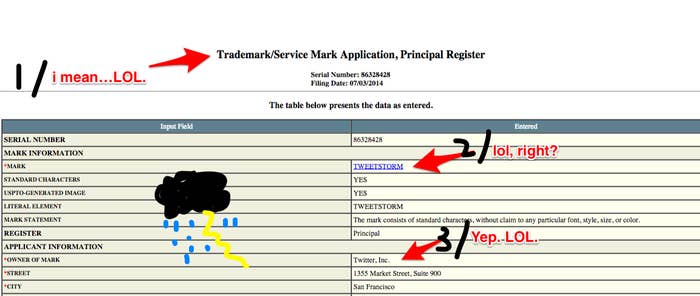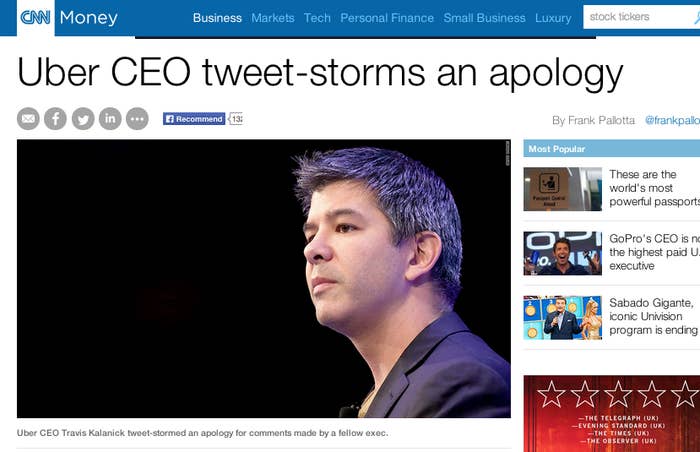
Yesterday, it was reported that Twitter filed a trademark application for the term “Tweetstorm,” and I have some thoughts about this.
Lol.
Glad that’s out of our systems.
As the tweetstorm evolves from a rare behavior practiced by a small group of Twitter power users to a legitimate, trademark-able Thing, it’s worth reflecting on what it is and what it means for a social network that is increasingly coming to influence the way we communicate, argue, and organize.
Here’s how I described the then-brand-new trend last May:
At its root, the Tweetstorm™ feels like an abuse of power/influence or, at the very least, a slightly inconsiderate, oblivious way to engage with people who’ve chosen to follow you (granted, users can obviously choose to opt-out at any time with an unfollow). In earnestly embarking on a Tweetstorm™, the Tweetstormer™ is tacitly admitting that he or she has many important things to say and an infinite listener attention span in which to say them.
In a conversation with Anil Dash, he described it as “timeline colonialism,” which I still think is a rather lovely turn of phrase. It touches on a feeling you get from a particularly patronizing ‘storm — the feeling that the ‘stormer is basically saying, "Look at these people. Walking around oblivious to my nuanced ideas about the 1099 economy! We can help them. Let’s give these people our ideas!"
At the time, I thought that that it was a little disrespectful of people’s time and timelines. So I wrote a dumb little thing that would maybe shed some light on this weird, preachy behavior. I used Chris Dixon’s “Tweetstorm™” term. I even used the trademark because I thought it was funny and absurd that somebody would trademark a buzzword for a string of silly tweets.
I was wrong. Twenty-seven days after the article was published, Twitter filed the trademark application.
None of this is funny.
But, like, still, lol.
In the months since, I’ve come around ever so slightly on the Tweetstorm™. As plenty have pointed out, it’s a nice way to work through some thoughts. And of course, participation on Twitter is not only optional — thank god! — but you don’t even have to follow anyone specifically. Therefore, I guess the point is a little bit moot. Somebody storms and you don’t like it? Just unfollow. Your feed, your rules.
And yet, I’m not totally ready to let this go. My big fear when I wrote the piece last May was that the Tweetstorm™ would spread from the dystopian world of Tech Twitter into other areas like politics and media. It totally did. And, in a lot of ways, it did what I was most concerned about: It gave yet another voice to the vociferous. Like mic'ing up a guy who already has a megaphone, Tweetstorms™ always seem to be a great opportunity for people who already have ample platforms and influence to have another say.

My colleague hit this on the head when he posed this question:
Do women ever tweetstorm?
Now, of course some women Tweetstorm™ from time to time and some are excellent and others are not so excellent and everything in between. But if we’re being honest with ourselves, the ratio is at best very skewed and at worst probably more than a little shameful.
It’s easy to dismiss dumb stuff on Twitter — it’s only Twitter! But the internet is real life, and it matters what voices we choose to amplify. Especially on a social network where women, people of color, LGBT people, and plenty of others find themselves being harassed and silenced and generally unwelcome every day, it’s important to think about the tools we’re creating and who is actually using them and to what end. Tweetstorms™ are a user-created Twitter thing and that’s fun and good and baked deep into the tradition of the social network. Tweetstorms™ aren’t bad, and people who Tweetstorm™ aren’t bad.
But Twitter has given voice to and created and strengthened communities that have traditionally and unjustly lived at a lower volume. Twitter is a rallying tool, it’s therapy, it’s a bullhorn to raise awareness, and even, in some cases, create movements that challenge outdated and entrenched institutions. So when you’re taking up real estate in someone’s feed, it’s worth thinking about which voices you’re pushing out of the cascade.
There is one silver lining, though. Twitter paid 975 U.S. dollars for the privilege of filing the trademark application.

I mean, they have the money, but still, lol. Owned.
